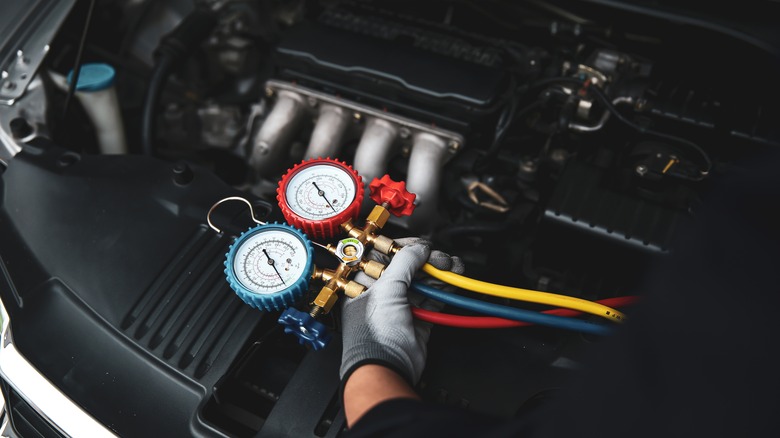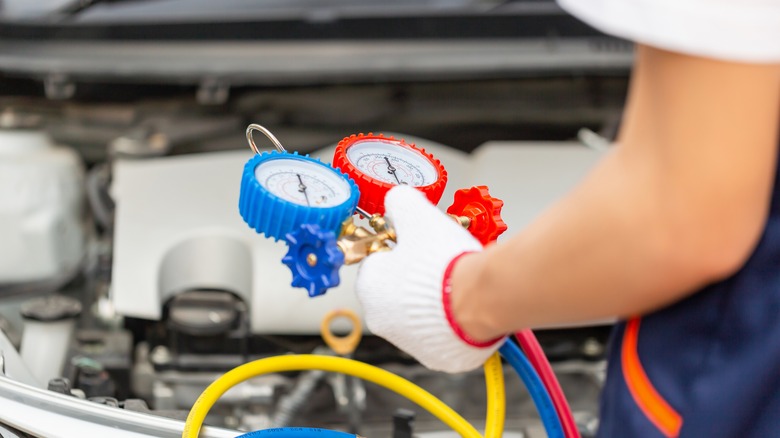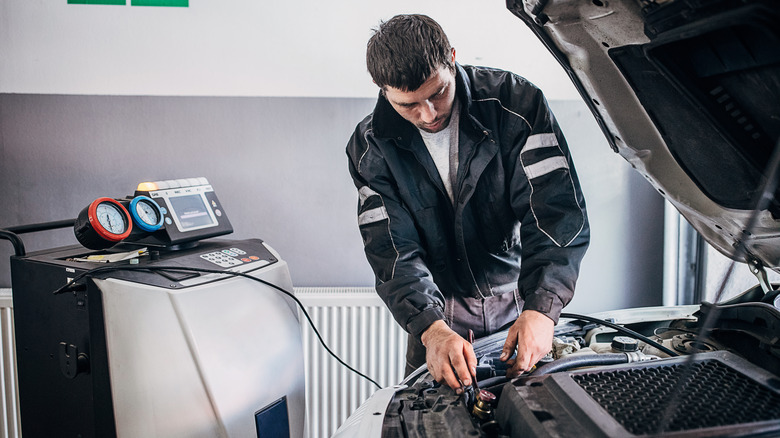How Much Does It Cost To Get Your Car's A/C Recharged?
With the hot months quickly approaching, it's important that your car's air conditioner produces cold air. Few things are worse than sitting in a hot car with an air conditioner that gives you no reprieve from the heat outside. If your car's air conditioner isn't producing the cold air you expect, it might be time to recharge it. Unfortunately, that means taking your car to a professional, which means spending money.
Just as you can save money when changing your car's air filter, you could attempt recharging the A/C yourself to save some money. In fact, there are some automotive diagnostic tools from Harbor Freight that can help you determine whether a recharge is necessary or not. However, a professional won't only solve the problem for you, they'll also be able to find the cause of the issue.
Rest assured, if you have to shell out some cash for an A/C recharge, it will only cost somewhere between $150 and $300. The cost will vary depending on the make and model of your vehicle. If you decide to go the DIY route, it only costs between $40-$60 for a recharge kit.
Signs you need to recharge your car's air conditioner
There are some obvious signs that your vehicle's air conditioner needs a recharge. Blowing out warm air, for example, is one clear sign you should take it into the shop. When the vehicle's refrigerant levels are too low, the evaporator core can't reach the optimal temperature for cooling. Sometimes that will cause the A/C to blow cool air initially, but will gradually shift to warm air. Other times, it's never cool air and will simply fill the cabin with warm air.
A visible leak under the chassis is another sign that something is afoot. A puddle of liquid could mean any number of things for a car, and one of those issues is a failing air conditioner. If you notice wet spots around A/C lines when you look under the hood, and the A/C isn't blowing cool air it's time to have your car serviced.
Whenever the air conditioner in a car is initiated, it's accompanied by a little "click" noise. That's the sound of the A/C clutch on the compressor engaging. If you don't hear that click, that's a sign that the refrigerant levels are either too high or too low, preventing the clutch from engaging. Lastly, take the vehicle in to be serviced as soon as you smell odd odors coming from the vents. A weird smell is indicative of water or mildew being present in the system, where it doesn't belong.
What it means to recharge the air conditioner
Recharging a vehicle's air conditioner should be done every 100,000 miles. For those without experience, it involves connecting the car to a device that removes refrigerant from the air conditioning system. While that's happening, the device simultaneously puts the vehicle under a vacuum to check the air conditioning system for leaks and identify where they are coming from.
The air conditioning system of all vehicles is a closed-loop system. Refrigerant levels won't be low unless there is a leak somewhere. While topping off the system with more refrigerant will get the A/C to blow cold air, it will eventually lose refrigerant again until the leak is fixed. If there are no issues with leaks and the system holds well under vacuum, the proper amounts of refrigerant are introduced into the system. Further tests are done to ensure the compressor delivers the appropriate cooling levels for the vehicle.
To recharge the air conditioner system yourself, you will need a vacuum pump, a manifold gauge, and refrigerant specifically for your vehicle's system. Recharging the system yourself also requires you to know which refrigerant to use. The standard for vehicles since 1994 has been R-134a. However, newer vehicles from the past few years require R-1234yf, which is a new generation of refrigerant.


